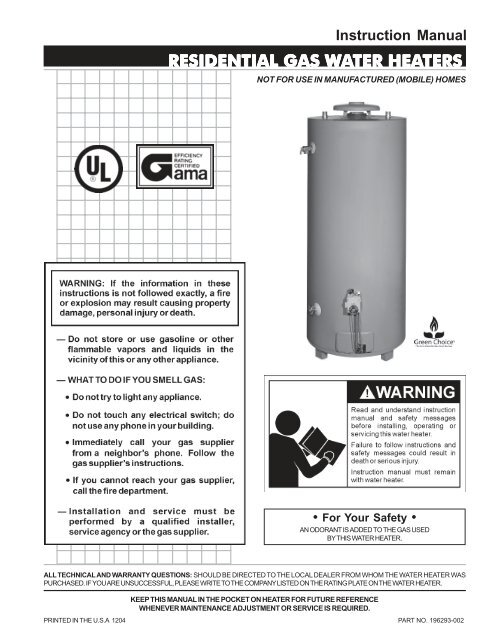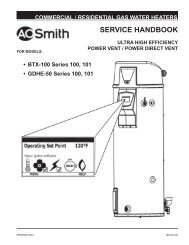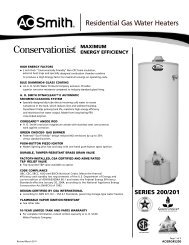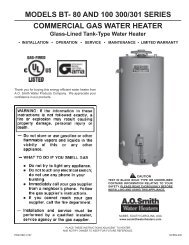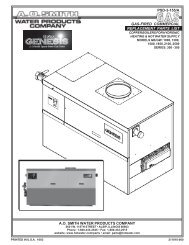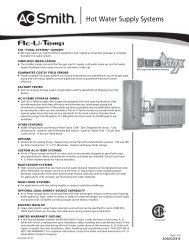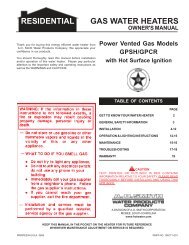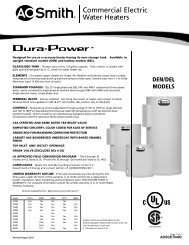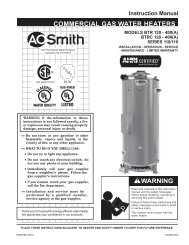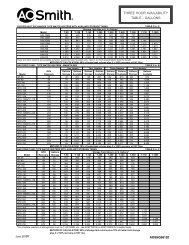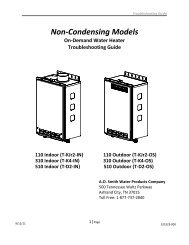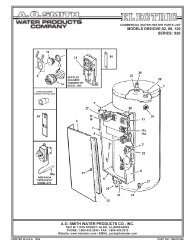Generic Single Flue 196293 002 1204.PMD
Generic Single Flue 196293 002 1204.PMD
Generic Single Flue 196293 002 1204.PMD
You also want an ePaper? Increase the reach of your titles
YUMPU automatically turns print PDFs into web optimized ePapers that Google loves.
Instruction ManualRESIDENTIAL GAS WATER HEATERSNOT FOR USE IN MANUFACTURED (MOBILE) HOMES• For Your Safety •AN ODORANT IS ADDED TO THE GAS USEDBY THIS WATER HEATER.ALL TECHNICAL AND WARRANTY QUESTIONS: SHOULD BE DIRECTED TO THE LOCAL DEALER FROM WHOM THE WATER HEATER WASPURCHASED. IF YOU ARE UNSUCCESSFUL, PLEASE WRITE TO THE COMPANY LISTED ON THE RATING PLATE ON THE WATER HEATER.KEEP THIS MANUAL IN THE POCKET ON HEATER FOR FUTURE REFERENCEWHENEVER MAINTENANCE ADJUSTMENT OR SERVICE IS REQUIRED.PRINTED IN THE U.S.A 1204 1PART NO. <strong>196293</strong>-<strong>002</strong>
SAFE INSTALLAALLATIONTION, , USE AND SERVICEYour safety and the safety of others is extremely important in the installation, use and servicing of this water heater.Many safety-related messages and instructions have been provided in this manual and on your own water heater to warn you andothers of a potential injury hazard. Read and obey all safety messages and instructions throughout this manual. It is veryimportant that the meaning of each safety message is understood by you and others who install, use or service this water heater.This is the safety alert symbol. It is used to alert youto potential personal injury hazards. Obey all safetymessages that follow this symbol to avoid possibleinjury or death.DANGERWARNINGCAUTIONCAUTIONDANGER indicates an imminentlyhazardous situation which, if not avoided,could result in death or injury.WARNING indicates a potentially hazardoussituation which, if not avoided, could resultin death or injury.CAUTION indicates a potentially hazardoussituation which, if not avoided, may resultin minor or moderate injury.CAUTION used without the safety alertsymbol indicates a potentially hazardoussituation which, if not avoided, could resultin property damage.All safety messages will generally tell you about the type of hazard, what can happen if you do not follow the safety message andhow to avoid the risk of injury.IMPORTANT DEFINITIONS• Qualified Installer: A qualified installer must have ability equivalent to a licensed tradesman in the fields of plumbing,air supply, venting and gas supply, including a thorough understanding of the requirements of the National Fuel GasCode as it relates to the installation of gas fired water heaters. The qualified installer must have a thorough understandingof this instruction manual.• Service Agency: A service agency also must have ability equivalent to a licensed tradesman in the fields of plumbing,air supply, venting and gas supply, including a thorough understanding of the requirements of the National Fuel GasCode as it relates to the installation of gas fired water heaters. The service agency must also have a thoroughunderstanding of this instruction manual, and be able to perform repairs strictly in accordance with the service guidelinesprovided by the manufacturer.• Gas Supplier: The Natural Gas or Propane Utility or service which supplies gas for utilization by the gas burningappliances within this application. The gas supplier typically has responsibility for the inspection and code approval ofgas piping up to and including the Natural Gas meter or Propane storage tank of a building. Many gas suppliers alsooffer service and inspection of appliances within the building.2
GENERAL SAFETY3
TABLE OF CONTENTSSAFE INSTALLATION, USE AND SERVICE .............................. 2GENERAL SAFETY .................................................................. 3TABLE OF CONTENTS .............................................................. 4INTRODUCTION ........................................................................ 4Preparing for the New Installation ................................... 4TYPICAL INSTALLATION .......................................................5,6LOCATING THE NEW WATER HEATER ................................. 7-9Facts to Consider About Location ................................7,8Insulation Blankets ........................................................... 8Combustion Air and Ventilation for AppliancesLocated in Unconfined Spaces ....................................... 8Combustion Air and Ventilation for AppliancesLocated in Confined Spaces .........................................8,9INSTALLING THE NEW WATER HEATER .......................... 10-14Water Piping .............................................................. 10,11Temperature-Pressure Relief Valve ............................... 11Filling the Water Heater .................................................. 12Venting ...................................................................... 12,13Gas Piping ................................................................. 13,14Sediment Traps .............................................................. 14LIGHTING & OPERATING INSTRUCTIONS .......................... 15,16TEMPERATURE REGULATION ................................................ 17FOR YOUR INFORMATION ................................................ 17,18Start Up Conditions ................................................... 17,18Draft Hood Operation .................................................. 17Condensation ......................................................... 17,18Smoke/Odor ................................................................ 18Thermal Expansion ...................................................... 18Strange Sounds .......................................................... 18Operational Conditions ................................................... 18Smelly Water ............................................................... 18“Air” in Hot Water Faucets ......................................... 18High Temperature Shut Off System ............................ 18PERIODIC MAINTENANCE ................................................. 19-21Venting System Inspection ............................................ 19Burner Inspection ........................................................... 19Burner Cleaning .............................................................. 19Housekeeping ........................................................... 19,20Anode Rod Inspection .................................................... 20Temperature-Pressure Relief Valve Operation .............. 20Draining .......................................................................... 20Drain Valve Washer Replacement ................................. 20Service ........................................................................... 21LEAKAGE CHECKPOINTS ...................................................... 21REPAIR PARTS ....................................................................... 22TROUBLESHOOTING GUIDELINES ......................................... 23WARRANTY ..................................................................... InsertINTRODUCTIONThank You for purchasing this water heater. Properly installed andmaintained, it should give you years of trouble free service.Abbreviations Found In This Instruction Manual:• UL - Underwriters Laboratories Inc.• ANSI - American National Standards Institute• NFPA - National Fire Protection Association• ASME - American Society of Mechanical Engineers• GAMA - Gas Appliance Manufacturer’s Association• CAN - Canada• EPACT - Energy Policy Act• CSA - Canadian Standards AssociationThis gas-fired water heater is design certified by UnderwritersLaboratories Inc. under American National Standard/CSA Standardfor Gas Water Heaters ANSI Z21.10.3 • CSA 4.3 (current edition).PREPARING FOR THE INSTALLATION1. Read the “General Safety” section, page 3 of this manual first andthen the entire manual carefully. If you don’t follow the safety rules,the water heater will not operate properly. It could cause DEATH,SERIOUS BODILY INJURY AND/OR PROPERTY DAMAGE.This manual contains instructions for the installation, operation, andmaintenance of the gas-fired water heater. It also contains warningsthroughout the manual that you must read and be aware of. Allwarnings and all instructions are essential to the proper operation ofthe water heater and your safety. Since we cannot put everythingon the first few pages, READ THE ENTIRE MANUAL BEFOREATTEMPTING TO INSTALL OR OPERATE THE WATER HEATER.42. The installation must conform with these instructions and the localcode authority having jurisdiction. In the absence of local codes,installations shall comply with the National Fuel Gas Code ANSIZ223.1/NFPA 54. This publication is available from the CSAInternational, 8501 East Pleasant Valley Rd., Cleveland Ohio 44131,or The National Fire Protection Association, 1 Batterymarch Park,Quincy, MA 02269.3. If after reading this manual you have any questions or do notunderstand any portion of the instructions, call the local gas utility orthe manufacturer whose name appears on the rating plate.4. Carefully plan the place where you are going to put the water heater.Correct combustion, vent action, and vent pipe installation are veryimportant in preventing death from possible carbon monoxidepoisoning and fires, see Figures 3 and 8.Examine the location to ensure the water heater complies with the“Locating the New Water Heater” section in this manual.5. For California installation this water heater must be braced, anchored,or strapped to avoid falling or moving during an earthquake. Seeinstructions for correct installation procedures. Instructions may beobtained from California Office of the State Architect, 400 P Street,Sacramento, CA 95814.6. Massachusetts Code requires this water heater to be installed inaccordance with Massachusetts 248-CMR 2.00: State Plumbing Codeand 248-CMR 5.00.7. Complies with SCAQMD rule #1146.2 and districts having equivalentNOx requirements.
TYPICAL INSTALLAALLATIONGET TO KNOW YOUR WATER HEATER - GAS MODELSABCDEFGHVent PipeDrafthoodAnodeHot Water OutletOutletInsulationGas SupplyManual Gas Shut-off ValveI Ground Joint UnionJ Drip Leg (Sediment Trap)K Inner DoorL Outer doorM UnionN Inlet Water Shut-off ValveO Cold Water InletP Inlet Dip TubeQRSTUVWXTemperature-Pressure Relief ValveRating Plate<strong>Flue</strong> Baffle(s)ThermostatDrain ValvePilot and Main Burner<strong>Flue</strong>Drain Pan* INSTALL IN ACCORDANCE WITHLOCAL CODES.(T) THERMOSTAT* DRIP LEG AS REQUIRED BYLOCAL CODES.* ALL PIPING MATERIALS TO BESUPPLIED BY CUSTOMERS.TO VENT TERMINATIONON ROOF(V) PILOT & MAIN BURNER - NATURAL GAS(V) PILOT & MAIN BURNER - PROPANE GASTHERMOCOUPLEPILOTBURNERMAINBURNER**CLOSED WATER SYSTEMS ARE THOSEWITH BACK FLOW PREVENTION DEVICESINSTALLED IN THE WATER SERVICE LINE.FIGURE 1.5
TYPICAL INSTALLAALLATIONMIXING VALVE USAGEFIGURE 2.This appliance has been design certified as complying with ANSI Z21.10.3latest edition for water heaters and is considered suitable for:Water (Potable) Heating and Space Heating: All models areconsidered suitable for water (potable) heating and space heating.6HOTTER WATER CAN SCALD:Water heaters are intended to produce hot water. Water heated toa temperature which will satisfy space heating, clothes washing,dish washing, and other sanitizing needs can scald and permanentlyinjure you upon contact. Some people are more likely to bepermanently injured by hot water than others. These include theelderly, children, the infirm, or physically/mentally handicapped. Ifanyone using hot water in your home fits into one of these groupsor if there is a local code requiring a certain temperature water atthe hot water tap, then you must take special precautions. In additionto using the lowest possible temperature setting that satisfies yourhot water needs, a means such as a *Mixing Valve, shall be used atthe hot water taps used by these people or at the water heater.Mixing valves are available at plumbing supply or hardware stores.Consult a qualified installer or service agency. Follow mixing valvemanufacturer’s instructions for installation of the valves. Beforechanging the factory setting on the thermostat, read the“Temperature Regulation” section in this manual, see Figures 15and 16.
LOCAOCATING THE NEW WATER HEATERFACTS TO CONSIDER ABOUT THE LOCATIONCarefully choose an indoor location for the new water heater, becausethe placement is a very important consideration for the safety of theoccupants in the building and for the most economical use of theappliance. This water heater is not for use in manufactured(mobile) homes or outdoor installation.Whether replacing an old water heater or putting the water heater in anew location, the following critical points must be observed:1. Select a location indoors as close as practical to the gas vent orchimney to which the water heater vent is going to be connected,and as centralized with the water piping system as possible.2. Selected location must provide adequate clearances for servicingand proper operation of the water heater.Installation of the water heater must be accomplished in such a mannerthat if the tank or any connections should leak, the flow will not causedamage to the structure. For this reason, it is not advisable to install thewater heater in an attic or upper floor. When such locations cannot beavoided, a suitable drain pan should be installed under the water heater.Drain pans are available at your local hardware store. Such a drainpan must have a minimum length and width of at least 2” (51 mm)greater than the water heater dimensions and must be piped to anadequate drain. The pan must not restrict combustion air flow.Water heater life depends upon water quality, water pressure and theenvironment in which the water heater is installed. Water heaters aresometimes installed in locations where leakage may result in propertydamage, even with the use of a drain pan piped to a drain. However,unanticipated damage can be reduced or prevented by a leak detectoror water shut-off device used in conjunction with a piped drain pan.These devices are available from some plumbing supply wholesalersand retailers, and detect and react to leakage in various ways:• Sensors mounted in the drain pan that trigger an alarm or turn offthe incoming water to the water heater when leakage is detected.• Sensors mounted in the drain pan that turn off the water supply tothe entire home when water is detected in the drain pan.• Water supply shut-off devices that activate based on the waterpressure differential between the cold water and hot water pipesconnected to the water heater.• Devices that will turn off the gas supply to a gas water heater whileat the same time shutting off its water supply.INSTALLATIONS IN AREAS WHERE FLAMMABLE LIQUIDS(VAPORS) ARE LIKELY TO BE PRESENT OR STORED (GARAGES,STORAGE AND UTILITY AREAS, ETC.): Flammable liquids (such asgasoline, solvents, propane [LP or butane, etc.] and other substancessuch as adhesives, etc.) emit flammable vapors which can be ignitedby a gas water heater’s pilot light or main burner. The resulting flashbackand fire can cause death or serious burns to anyone in the area, aswell as property damage. If installation in such areas is your onlyoption, then the installation must be accomplished in a way that the pilotflame and main burner flame are elevated from the floor at least 18inches. While this may reduce the chances of flammable vapors, froma floor spill being ignited, gasoline and other flammable substancesshould never be stored or used in the same room or area containing agas water heater or other open flame or spark producing appliance.NOTE: Flammable vapors may be drawn by air currents from otherareas of the structure to the appliance.Also, the water heater must be located and/or protected so it is notsubject to physical damage by a moving vehicle.This water heater must not be installed directly on carpeting. Carpetingmust be protected by metal or wood panel beneath the applianceextending beyond the full width and depth of the appliance by at least3” (76.2 mm) in any direction, or if the appliance is installed in an alcoveor closet, the entire floor must be covered by the panel. Failure to heedthis warning may result in a fire hazard.7
Minimum clearances between the water heater and combustibleconstruction are 0 inch at the sides and rear, 4” (102 mm) at the front,and 6” (153 mm) from the vent pipe. Clearance from the top of thejacket is 12” (305 mm) on most models. Note that a lesser dimensionmay be allowed on some models, refer to the label attached adjacent tothe gas control valve on the water heater, see Figure 3.INSULATION BLANKETSFIGURE 3.FIGURE 3.Insulation blankets are available to the general public for external useon gas water heaters but are not necessary with these products. Thepurpose of an insulation blanket is to reduce the standby heat lossencountered with storage tank heaters. Your water heater meets orexceeds the EPACT standards with respect to insulation and standbyloss requirements, making an insulation blanket unnecessary.Should you choose to apply an insulation blanket to this heater, youshould follow these instructions (For identification of componentsmentioned below, see Figure 1). Failure to follow these instructionscan restrict the air flow required for proper combustion, potentiallyresulting in fire, asphyxiation, serious personal injury or death.• Do not apply insulation to the top of the water heater, as this willinterfere with safe operation of the draft hood.• Do not cover the outer door, thermostat or temperature & pressurerelief valve.A gas water heater cannot operate properly without the correct amountof air for combustion. Do not install in a confined area such as a closet,unless you provide air as shown in the “Locating The New WaterHeater” section. Never obstruct the flow of ventilation air. If you haveany doubts or questions at all, call your gas supplier. Failure to providethe proper amount of combustion air can result in a fire or explosionand cause death, serious bodily injury, or property damage.• Do not allow insulation to come within 2" (50.8 mm) of the floor toprevent blockage of combustion air flow to the burner.• Do not cover the instruction manual. Keep it on the side of thewater heater or nearby for future reference.• Do obtain new warning and instruction labels from the manufacturerfor placement on the blanket directly over the existing labels.• Do inspect the insulation blanket frequently to make certain itdoes not sag, thereby obstructing combustion air flow.FIGURE 4.If this water heater will be used in beauty shops, barber shops, cleaningestablishments, or self-service laundries with dry cleaning equipment,it is imperative that the water heater or water heaters be installed sothat combustion and ventilation air be taken from outside these areas.Propellants of aerosol sprays and volatile compounds, (cleaners,chlorine based chemicals, refrigerants, etc.) in addition to being highlyflammable in many cases, will also change to corrosive hydrochloricacid when exposed to the combustion products of the water heater.The results can be hazardous, and also cause product failure.8COMBUSTION AIR AND VENTILATION FORAPPLIANCES LOCATED IN UNCONFINED SPACESUNCONFINED SPACE is space whose volume is not less than50 cubic feet per 1,000 Btu per hour (4.8 m 3 per kW) of the aggregateinput rating of all appliances installed in that space. Roomscommunicating directly with the space in which the appliances areinstalled, through openings not furnished with doors, are considered apart of the unconfined space.In unconfined spaces in buildings, infiltration may be adequate to provideair for combustion, ventilation and dilution of flue gases. However, inbuildings of tight construction (for example, weather stripping, heavilyinsulated, caulked, vapor barrier, etc.), additional air may need to beprovided using the methods described in “Combustion Air and Ventilationfor Appliances Located in Confined Spaces.”COMBUSTION AIR AND VENTILATION FORAPPLIANCES LOCATED IN CONFINED SPACESCONFINED SPACE is a space whose volume is less than 50 cubic feetper 1,000 Btu per hour (4.8 m 3 per kW) of the aggregate input rating ofall appliances installed in that space.
A. ALL AIR FROM INSIDE BUILDINGS: (See Figures 4 and 5)The confined space shall be provided with two permanent openingscommunicating directly with an additional room(s) of sufficient volumeso that the combined volume of all spaces meets the criteria for anunconfined space. The total input of all gas utilization equipment installedin the combined space shall be considered in making this determination.Each opening shall have a minimum free area of one square inch per1,000 Btu per hour (22 cm 2 /kW) of the total input rating of all gasutilization equipment in the confined space, but not less than 100 squareinches (645 cm 2 ). One opening shall commence within 12”(30 cm) of the top and one commencing within 12” (30 cm) of thebottom of the enclosures.Btu per hour (5.5 cm 2 /kW) of total input rating of all equipment in theenclosure, see Figure 7.3. When communicating with the outdoors through horizontal ducts,each opening shall have a minimum free area of 1 square inch per2,000 Btu per hour (11 cm 2 /kW)) of total input rating of all equipmentin the enclosure, see Figure 8.FIGURE 7.FIGURE 5.B. ALL AIR FROM OUTDOORS: (See Figures 6, 7 and 8)4. When ducts are used, they shall be of the same cross-sectionalarea as the free area of the openings to which they connect. Theminimum short side dimension of rectangular air ducts shall not beless than 3” (76.2 mm), see Figure 8.The confined space shall be provided with two permanent openings,one commencing within 12” (30 cm) of the top and onecommencing within 12” (30 cm) from the bottom of the enclosure. Theopenings shall communicate directly, or by ducts, with the outdoors orspaces (crawl or attic) that freely communicate with the outdoors.1. When directly communicating with the outdoors, each opening shallhave a minimum free area of 1 square inch per 4,000 Btu per hour(5.5 cm 2 /kW) of total input rating of all equipment in the enclosure, seeFigure 6.FIGURE 6.2. When communicating with the outdoors through vertical ducts, eachopening must have a minimum free area of 1 square inch per 4,0009FIGURE 8.5. Louvers and Grilles: In calculating free area, consideration shall begiven to the blocking effect of louvers, grilles or screens protectingopenings. Screens used shall not be smaller than 1/4 inch(6.4 mm) mesh. If the free area through a design of louver or grilleis known, it should be used in calculating the size opening requiredto provide the free area specified. If the design and free area is notknown, it may be assumed that wood louvers will be 20-25 percentfree area and metal louvers and grilles will have 60-75 percent freearea. Louvers and grilles shall be fixed in the open position orinterlocked with the equipment so that they are opened automaticallyduring equipment operation.6. Special Conditions Created by Mechanical Exhausting or Fireplaces:operation of exhaust fans, ventilation systems, clothes dryers orfireplaces may create conditions requiring special attention to avoidunsatisfactory operation of installed gas utilization equipment.
INSTALLING THE NEW WATER HEATERWATER PIPINGAs water is heated, it expands (thermal expansion) and closed systemsdo not allow for the expansion of heated water.The water within the water heater tank expands as it is heated andincreases the pressure of the water system. If the relieving point of thewater heater’s temperature-pressure relief valve is reached, the valvewill relieve the excess pressure. The temperature-pressure reliefvalve is not intended for the constant relief of thermalexpansion. This is an unacceptable condition and must be corrected.It is recommended that any devices installed which could create a closedsystem have a by-pass and/or the system have an expansion tank torelieve the pressure built by thermal expansion in the water system.Expansion tanks are available for ordering through a local plumbingcontractor. Refer to the “Thermal Expansion” section in this manual and/or contact the local water supplier and/or a service agency for assistancein controlling these situations.HOTTER WATER CAN SCALD:Water heaters are intended to produce hot water. Water heated to atemperature which will satisfy space heating, clothes washing, dishwashing, cleaning and other sanitizing needs can scald and permanentlyinjure you upon contact. Some people are more likely to be permanentlyinjured by hot water than others. These include the elderly, children, theinfirm, or physically/mentally handicapped. If anyone using hot water inyour home fits into one of these groups or if there is a local code or statelaw requiring a certain temperature water at the hot water tap, then youmust take special precautions. In addition to using the lowest possibletemperature setting that satisfies your hot water needs, a means suchas a *mixing valve, shall be used at the hot water taps used by thesepeople or at the water heater, see Figure 2. Valves for reducing point ofuse temperature by mixing cold and hot water are also available. Consulta qualified installer or service agency. Follow manufacturer’sinstructions for installation of the valves. Before changing the factorysetting on the thermostat, read the “Temperature Regulation” section inthis manual.NOTE: To protect against untimely corrosion of hot and coldwater fittings, it is strongly recommended that di-electric unionsor couplings be installed on this water heater when connectedto copper pipe.This water heater shall not be connected to any heating systems orcomponent(s) used with a non-potable water heating appliance.All piping components connected to this unit for space heatingapplications shall be suitable for use with potable water.Toxic chemicals, such as those used for boiler treatment shall not beintroduced into this system.When the system requires water for space heating at temperatureshigher than required for domestic water purposes, a tempering valvemust be installed. Please refer to Figure 2 for suggested pipingarrangement.Water supply systems may, because of such events as high linepressure, frequent cut-offs, the effects of water hammer among others,have installed devices such as pressure reducing valves, check valves,back flow preventers, etc. to control these types of problems. Whenthese devices are not equipped with an internal by-pass, and no othermeasures are taken, the devices cause the water system to be closed.10FIGURE 9.
Figure 9 shows the typical attachment of the water piping to the waterheater. The water heater is equipped with 1” NPT threaded nipple(75 gallon models) or 1.25” NPT threaded nipple (100 gallon models)water connections.NOTE: If using copper tubing, solder tubing to an adapter beforeattaching the adapter to the cold water inlet connection. Do notsolder the cold water supply line directly to the cold water inlet.It will harm the dip tube and damage the tank.TEMPERATURE-PRESSURE RELIEF VALVEThe Discharge Pipe:• Shall not be smaller in size than the outlet pipe size of the valve, orhave any reducing couplings or other restrictions.• Shall not be plugged or blocked.• Shall be of material listed for hot water distribution.• Shall be installed so as to allow complete drainage of both thetemperature-pressure relief valve, and the discharge pipe.• Shall terminate at an adequate drain.• Shall not have any valve between the relief valve and tank.This heater is provided with a properly certified combinationtemperature - pressure relief valve by the manufacturer.The valve is certified by a nationally recognized testing laboratory thatmaintains periodic inspection of production of listed equipment ofmaterials as meeting the requirements for Relief Valves and AutomaticGas Shut-off Devices for Hot Water Supply Systems, ANSI Z21.22 • CSA4.4, and the code requirements of ASME.If replaced, the valve must meet the requirements of local codes, but notless than a combination temperature and pressure relief valve certifiedas indicated in the above paragraph.The valve must be marked with a maximum set pressure not to exceedthe marked maximum working pressure of the water heater(150 psi = 1,035 kPa) and a discharge capacity not less than the waterheater input rate as shown on the model rating plate.The temperature-pressure relief valve must be manually operated atleast once a year. Caution should be taken to ensure that (1) no one isin front of or around the outlet of the temperature-pressure reliefvalve discharge line, and (2) the water manually discharged will notcause any bodily injury or property damage because the water may beextremely hot.If after manually operating the valve, it fails to completely reset andcontinues to release water, immediately close the cold water inlet to thewater heater, follow the draining instructions, and replace thetemperature-pressure relief valve with a new one.For safe operation of the water heater, the relief valve must not beremoved from its designated opening nor plugged.The temperature-pressure relief valve must be installed directly into thefitting of the water heater designed for the relief valve. Position thevalve downward and provide tubing so that any discharge will exit onlywithin 6” (153 mm) above, or at any distance below the structural floor.Be certain that no contact is made with any live electrical part. Thedischarge opening must not be blocked or reduced in size under anycircumstances. Excessive length, over 30’ (9.14 m), or use of more thanfour elbows can cause restriction and reduce the discharge capacity ofthe valve, see Figure 10.No valve or other obstruction is to be placed between the relief valveand the tank. Do not connect tubing directly to discharge drain unless a6 inch air gap is provided. To prevent bodily injury, hazard to life, orproperty damage, the relief valve must be allowed to discharge water inquantities should circumstances demand. If the discharge pipe is notconnected to a drain or other suitable means, the water flow may causeproperty damage.11FIGURE 10.
FILLING THE WATER HEATERVent dampers must bear evidence of certification as complying withthe current edition of the American National Standard ANSI Z21.66CGA 6.14 (covering electrically and mechanically actuated ventdampers). Before installation of any vent damper, consult the localgas utility for further information.To insure proper venting of this gas-fired water heater, the correctvent pipe diameter must be utilized. Any additions or deletions of othergas appliances on a common vent with this water heater may adverselyaffect the operation of the water heater. Consult your gas supplier ifany such changes are planned.Never use this water heater unless it is completely full of water. Toprevent damage to the tank, the tank must be filled with water. Watermust flow from the hot water faucet before turning “ON” gas to thewater heater.To fill the water heater with water:1. Close the water heater drain valve by turning the handle to the right(clockwise). The drain valve is on the lower front of the waterheater.2. Open the cold water supply valve to the water heater.NOTE: The cold water supply valve must be left open whenthe water heater is in use.3. To insure complete filling of the tank, allow air to exit by opening thenearest hot water faucet. Allow water to run until a constant flowis obtained. This will let air out of the water heater and the piping.4. Check all water piping and connections for leaks. Repair as needed.VENTINGFor proper venting in certain installations, a larger diameter vent pipemay be necessary. Consult your gas supplier to aid you in determiningthe proper venting for your water heater from the vent tables in thecurrent edition of the National Fuel Gas Code ANSI Z223.1/NFPA 54.Periodically check the venting system for signs of obstruction ordeterioration and replace if needed.The combustion and ventilation air flow must not be obstructed.The water heater with draft hood installed must be connected to achimney or listed vent pipe system, which terminates to the outdoors.Never operate the water heater unless it is vented to the outdoors andhas adequate air supply to avoid risks of improper operation, explosionor asphyxiation.• For proper draft hood attachment, the draft hood legs may be angledslightly inward.• Place the draft hood legs in the receiving holes on the top of thewater heater. The legs will snap in the holes to give a tight fit.Secure draft hood with the supplied brackets.• Place the vent pipe over the draft hood. With the vent pipe in position,drill a small hole through both the vent pipe and draft hood. Securethem together with a sheet metal screw, see Figure 11.Obstructed or deteriorated vent systems may present serious healthrisk or asphyxiation.FIGURE 11.VENT DAMPERS - Any vent damper, whether it is operated thermally orotherwise must be removed if its use inhibits proper drafting of thewater heater.The vent pipe from the water heater must be no less than the diameterof the draft hood outlet on the water heater and must slope upward atleast 1/4 inch per linear foot (21 mm per meter), see Figure 12.Thermally Operated Vent Dampers: this gas-fired water heater has athermal efficiency at or above 80% which may produce a relativelylow flue gas temperature. Such temperatures may not be high enoughto properly open thermally operated vent dampers. This would causespillage of the flue gases and may cause carbon monoxide poisoning.12All vent gases must be completely vented to the outdoors of thestructure (dwelling). Install only the draft hood provided with the newwater heater and no other draft hood.Vent pipes must be secured at each joint with sheet metal screws.
Make sure the gas supplied is the same type listed on the model ratingplate. The inlet gas pressure must not exceed 14 inch water column(2.6 kPa) for natural and propane (L.P.) gas. The minimum inlet gaspressure shown on the rating plate is that which will permit firing atrated input.FIGURE 12.There must be a minimum of 6” (153 mm) clearance between singlewall vent pipe and any combustible material. Fill and seal any clearancebetween single wall vent pipe and combustible material with mortarmix, cement, or other noncombustible substance. For other than singlewall, follow vent pipe manufacturer’s clearance specifications. Toinsure a tight fit of the vent pipe in a brick chimney, seal around the ventpipe with mortar mix cement.Failure to have required clearances between vent piping and combustiblematerial will result in a fire hazard.Be sure vent pipe is properly connected to prevent escape of dangerousflue gases which could cause deadly asphyxiation.If the gas control valve is subjected to pressures exceeding 1/2 poundper square inch (3.5 kPa), the damage to the gas control valve couldresult in a fire or explosion from leaking gas.If the main gas line shut-off serving all gas appliances is used, also turn“off” the gas at each appliance. Leave all gas appliances shut “off”until the water heater installation is complete.A gas line of sufficient size must be run to the water heater. Consultthe current edition of National Fuel Gas Code ANSI Z223.1/NFPA 54 andyour gas supplier concerning pipe size.There must be:• A readily accessible manual shut off valve in the gas supply lineserving the water heater, and• A drip leg (sediment trap) ahead of the gas control valve to helpprevent dirt and foreign materials from entering the gas controlvalve.• A flexible gas connector or a ground joint union between the shutoff valve and control valve to permit servicing of the unit.Be sure to check all the gas piping for leaks before lighting the waterheater. Use a soapy water solution, not a match or open flame. Rinseoff soapy solution and wipe dry.The minimum inlet gas pressure shown on the rating plate is that whichwill permit firing at the rated input.Chemical vapor corrosion of the flue and vent system may occur if airfor combustion contains certain chemical vapors. Spray canpropellants, cleaning solvents, refrigerator and air conditionerrefrigerants, swimming pool chemicals, calcium and sodium chloride,waxes, bleach and process chemicals are typical compounds whichare potentially corrosive.GAS PIPINGStandard Models are for installation up to 2,000 feet (610 m) abovesea level.13High Altitude models are for installation from 2,000 feet(610 m) to 4,500 feet (1,370 m) above sea level.If a standard model is installed above 2,000 feet (610 m) or high altitudemodel is installed above 4,500 feet (1,370 m), the input rating should bereduced at the rate of 4 percent for each 1000 feet (305 m) above sealevel which requires replacement of the burner orifice in accordancewith National Fuel Gas Code ANSI Z223.1/NFPA 54 or Contact yourlocal gas supplier for further information.Failure to replace the standard orifice with a high altitude orifice wheninstalled at elevations above 2,000 feet (610 m) or above 4,500 feet(1,370 m) for high altitude model could result in improper and inefficientoperation of the appliance, producing carbon monoxide gas in excessof safe limits, which could result in serious injury or death. Contactyour local gas supplier for any specific changes which may berequired in your area.
FIGURE 14. GAS PIPING WITH ALLBLACK IRON PIPE TO GAS CONTROL.Use pipe joint compound or teflon tape marked as being resistant to theaction of petroleum [Propane (L.P.)] gases.The appliance and its gas connection must be leak tested before placingthe appliance in operation.The appliance and its individual shut-off valve shall be disconnectedfrom the gas supply piping system during any pressure testing of thatsystem at test pressures in excess of 1/2 pound per square inch(3.5 kPa). It shall be isolated from the gas supply piping system byclosing its individual manual shut-off valve during any pressure testingof the gas supply piping system at test pressures equal to or less than1/2 pound per square inch (3.5 kPa).SEDIMENT TRAPSA sediment trap shall be installed as close to the inlet of the waterheater as practical at the time of water heater installation. The sedimenttrap shall be either a tee fitting with a capped nipple in the bottom outletor other device recognized as an effective sediment trap. If a tee fittingis used, it shall be installed in conformance with one of the methods ofinstallation shown in Figures 13 and 14.Connecting the gas piping to the gas control valve of the water heatercan be accomplished by either of the two methods shown in Figures13 and 14.FIGURE 13. GAS PIPING WITH FLEXIBLE CONNECTOR.Contaminants in the gas lines may cause improper operation of the gascontrol valve that may result in fire or explosion. Before attaching thegas line be sure that all gas pipe is clean on the inside. To trap any dirtor foreign material in the gas supply line, a drip leg (sometimes called asediment trap) must be incorporated in the piping. The drip leg must bereadily accessible. Install in accordance with the “Gas Piping” section.Refer to the current edition of the National Fuel Gas Code, ANSI Z223.1/NFPA 54.14
FOR YOUR SAFETY READ BEFORE LIGHTINGWARNING: If you do not follow these instructions exactly, a fire orexplosion may result causing property damage, personal injury or loss of life.BEFORE LIGHTING: ENTIRE SYSTEM MUST BE FILLED WITH WATER AND AIR PURGED AT FAUCETS.A. This appliance has a pilot which must be lighted by hand.When lighting the pilot, follow these instructions exactly.B. BEFORE LIGHTING: smell all around the appliance areafor gas. Be sure to smell next to the floor because somegas is heavier than air and will settle on the floor.WHAT TO DO IF YOU SMELL GAS• Do not try to light any appliance.• Do not touch any electric switch; do not useany phone in your building.• Immediately call your gas supplier from aneighbor’s phone. Follow the gas supplier’sinstructions.• If you cannot reach your gas supplier, call thefire department.C. Use only your hand to push down or turn the gas controlknob. Never use tools. If the knob will not push down orturn by hand, don’t try to repair it, call a qualified servicetechnician. Force or attempted repair may result in a fireor explosion.D. Do not use this appliance if any part has been under water.Immediately contact a qualified installer or service agencyto replace a flooded water heater. Do not attempt to repairthe unit! It must be replaced!LIGHTING INSTRUCTIONSGAS CONTROLTOP VIEWFIGURE “D”1. STOP! Read the safety information above onthis label.2. Set the thermostat to the lowest setting by turningthermostat dial fully clockwise until it stops.3. Push the gas control knob down slightly and turn clockwiseto "OFF" (Figure A).NOTE: Gas control knob CANNOT be turned from "PILOT"to "OFF" unless it is pushed down slightly. Do not force.4. Remove the inner and outer doors located below andbehind the gas control unit.5. Wait five (5) minutes to clear out any gas. If you thensmell gas STOP! Follow "B" in the safety informationabove on this label. If you do not smell gas, go tothe next step.6. Find Pilot. Follow metal tube from the bottom , right of thegas control to the pilot burner (Figure D).7. Turn gas control knob counterclockwise to "PILOT"(Figure B).8. Push gas control knob down all the way and hold it down.Immediately light the pilot with a match. Continue to holdthe gas control knob down for about one (1) minute afterthe pilot is lit. Release the gas control knob and it will popback up. Pilot should remain lit. If it goes out, repeat Steps3 through 8. It may take several minutes for air to clearthe lines, before the pilot will light.• If knob does not pop up when released, stopand immediately call your service technicianor gas supplier.• If the pilot will not stay lit after several tries, turnthe gas control knob to "OFF" (Figure A) andcall your service technician or gas supplier.9. Replace inner and outer burner doors.10. At arm's length away, turn gas control knobcounterclockwise to “ON” (Figure C).11. Set thermostat to desired setting (See Figure).CAUTION: Hotter water increases the risk ofscald injury. Consult the instruction manualbefore changing temperature.TO TURN OFF GAS TO APPLIANCE1. Set thermostat to the lowest setting.2. Push gas control knob down slightly and turn clockwiseto “OFF”. Do not force, see Figure A.15
FOR YOUR SAFETY READ BEFORE LIGHTINGWARNING: If you do not follow these instructions exactly, a fire orexplosion may result causing property damage, personal injury or loss of life.BEFORE LIGHTING: ENTIRE SYSTEM MUST BE FILLED WITH WATER AND AIR PURGED AT FAUCETS.A. This appliance has a pilot which must be lighted by hand.When lighting the pilot, follow these instructions exactly.B. BEFORE LIGHTING: smell all around the appliance areafor gas. Be sure to smell next to the floor because somegas is heavier than air and will settle on the floor.WHAT TO DO IF YOU SMELL GAS• Do not try to light any appliance.• Do not touch any electric switch; do not useany phone in your building.• Immediately call your gas supplier from aneighbor’s phone. Follow the gas supplier’sinstructions.• If you cannot reach your gas supplier, call thefire department.C. Use only your hand to push down or turn the gas controlknob. Never use tools. If the knob will not push down orturn by hand, don’t try to repair it, call a qualified servicetechnician. Force or attempted repair may result in a fireor explosion.D. Do not use this appliance if any part has been under water.Immediately contact a qualified installer or service agencyto replace a flooded water heater. Do not attempt to repairthe unit! It must be replaced!LIGHTING INSTRUCTIONSGAS CONTROLTOP VIEWFIGURE “D”1. STOP! Read the safety information above onthis label.2. Set the thermostat to the lowest setting by turningthermostat dial fully clockwise until it stops.3. Push the gas control knob down slightly and turn clockwiseto "OFF" (Figure A).NOTE: Gas control knob CANNOT be turned from "PILOT"to "OFF" unless it is pushed down slightly. Do not force.4. Remove the inner and outer doors located below andbehind the gas control unit.5. Wait five (5) minutes to clear out any gas. If you thensmell gas STOP! Follow "B" in the safety informationabove on this label. If you do not smell gas, go tothe next step.6. Find Pilot. Follow metal tube from the bottom , right of thegas control to the pilot burner. (Figure D).7. Turn gas control knob counterclockwise to "PILOT"(Figure B).8. Push gas control knob down all the way and hold it down.Immediately light the pilot with a match. Continue to holdthe gas control knob down for about one (1) minuteafter the pilot is lit. Release the gas control knob and itwill pop back up. Pilot should remain lit. If it goes out,repeat Steps 3 through 8. It may take several minutes forair to clear the lines, before the pilot will light.• If knob does not pop up when released, stop andimmediately call your service technician or gassupplier.• If the pilot will not stay lit after several tries, turn thegas control knob to "OFF" (Figure A) and call yourservice technician or gas supplier.9. Replace inner and outer burner doors.10. At arm's length away, turn the gas control knobcounterclockwise to “ON” (Figure C).11. Set thermostat to desired setting (See Figure).CAUTION: Hotter water increases the risk ofscald injury. Consult the instruction manualbefore changing temperature.TO TURN OFF GAS TO APPLIANCE1. Set the thermostat to lowest setting. 2. Push gas control knob down slightly and turn clockwiseto “OFF”. Do not force, see Figure A.16
Short repeated heating cycles caused by small hot water uses cancause temperatures at the point of use to exceed the thermostat settingby up to 30°F (16.7°C). If you experience this type of use you shouldconsider using lower temperature settings to reduce scald hazards.Any water heater’s intended purpose is to heat water. Hot water isneeded for cleansing, cleaning, and sanitizing (bodies, dishes, clothing).Untempered hot water can present a scald hazard. Depending on thetime element, and the people involved (adults, children, elderly, infirm,etc.) scalding may occur at different temperatures.TEMPERATURE TURE REGULATIONNever allow small children to use a hot water tap, or to draw their ownbath water. Never leave a child or handicapped person unattended ina bathtub or shower.NOTE: A water temperature range of 120°F-140°F (49°C-60°C) isrecommended by most dishwasher manufacturers.The thermostat of this water heater has been factory set at its lowestposition (PILOT LIGHTING). It is adjustable and must be reset to thedesired temperature setting to reduce the risk of scald injury. The mark( ) indicative of approximately 120°F (49°C) is preferred startingpoint. Some States have a requirement for a lower setting.Turn the water temperature dial clockwise ( ) to decrease thetemperature, or counterclockwise ( ) to increase the temperature.Should overheating occur or the gas supply fail to shut off, turn off themanual gas control valve to the appliance.HOTTER WATER CAN SCALD: Water heaters are intended to producehot water. Water heated to a temperature which will satisfy spaceheating, clothes washing, dish washing, and other sanitizing needscan scald and permanently injure you upon contact. Some people aremore likely to be permanently injured by hot water than others. Theseinclude the elderly, children, the infirm, or physically/mentallyhandicapped. If anyone using hot water in your home fits into one ofthese groups or if there is a local code or state law requiring a certaintemperature water at the hot water tap, then you must take specialprecautions. In addition to using the lowest possible temperature settingthat satisfies your hot water needs, a means such as a mixing valve,shall be used at the hot water taps used by these people or at thewater heater. Mixing valves are available at plumbing supply orhardware stores, see Figure 2. Follow manufacturer’s instructions forinstallation of the valves. Before changing the factory setting on thethermostat, read the “Temperature Regulation” section in this manual,see Figures 15 and 16.FIGURE 15.TemperatureTime to Produce 2nd & 3rdSettingsDegree Burns on Adult SkinVERY HOT= approx. 160°F (71°C) About 1/2 secondC = approx. 150°F (66°C)About 1-1/2 secondsB = approx. 140°F (60°C)Less than 5 secondsA = approx. 130°F (54°C)About 30 seconds= approx. 120°F (49°C) More than 5 minutesLOW = approx. 80°F (27°C) - - - - - - - - - - - - - - - -FIGURE 16.START UP CONDITIONSDRAFT HOOD OPERATIONCheck draft hood operation by performing a worst case depressurizationof the building. With all doors and windows closed, and with all airhandling equipment and exhaust fans operating such as furnaces, clothesdryers, range hoods and bathroom fans, a match flame should still bedrawn into the draft hood of the water heater with its burner firing. If theflame is not drawn toward the draft hood, shut off water heater andmake necessary air supply changes to correct.CONDENSATIONWhenever the water heater is filled with cold water, some condensateFOR YOUR INFORMATION17will form while the burner is on. A water heater may appear to be leakingwhen in fact the water is condensation. This usually happens when:a. A new water heater is filled with cold water for the first time.b. Burning gas produces water vapor in water heaters, particularlyhigh efficiency models where flue temperatures are lower.c. Large amounts of hot water are used in a short time and the refillwater in the tank is very cold.Moisture from the products of combustion condense on the cooler tanksurfaces and form drops of water which may fall onto the burner orother hot surfaces to produce a “sizzling” or “frying” noise.Excessive condensation can cause pilot outage due to water runningdown the flue tube onto the main burner and putting out the pilot.
Because of the suddenness and amount of water, condensation watermay be diagnosed as a “tank leak”. After the water in the tank warms up(about 1-2 hours), the condition should disappear.Do not assume the water heater is leaking until there has been enoughtime for the water in the tank to warm up.An undersized water heater will cause more condensation. The waterheater must be sized properly to meet the family’s demands for hot waterincluding dishwashers, washing machines and shower heads.Excessive condensation may be noticed during the winter and earlyspring months when incoming water temperatures are at their lowest.Good venting is essential for a gas fired water heater to operate properlyas well as to carry away products of combustion and water vapor.SMOKE / ODORIt is not uncommon to experience a small amount of smoke and odorduring the initial start-up. This is due to burning off of oil from metal parts,and will disappear in a short while.THERMAL EXPANSIONOPERATIONAL CONDITIONSSMELLY WATERIn each water heater there is installed at least one anode rod (seeparts section) for corrosion protection of the tank. Certain waterconditions will cause a reaction between this rod and the water. Themost common complaint associated with the anode rod is one of a“rotten egg smell” in the hot water. This odor is derived from hydrogensulfide gas dissolved in the water. The smell is the result of fourfactors which must all be present for the odor to develop:a. A concentration of sulfate in the supply water.b. Little or no dissolved oxygen in the water.c. A sulfate reducing bacteria which has accumulated within the waterheater (this harmless bacteria is nontoxic to humans).d. An excess of active hydrogen in the tank. This is caused by thecorrosion protective action of the anode.Smelly water may be eliminated or reduced in some water heatermodels by replacing the anode(s) with one of less active material, andthen chlorinating the water heater tank and all hot water lines. Contactthe local water heater supplier or service agency for further informationconcerning an Anode Replacement Kit and this chlorination treatment.If the smelly water persists after the anode replacement and chlorinationtreatment, we can only suggest that chlorination or aeration of thewater supply be considered to eliminate the water problem.Do not remove the anode leaving the tank unprotected. Bydoing so, all warranty on the water heater tank is voided.“AIR” IN HOT WATER FAUCETSWater supply systems may, because of such events as high linepressure, frequent cut-offs, the effects of water hammer amongothers, have installed devices such as pressure reducing valves, checkvalves, back flow preventers, etc. to control these types of problems.When these devices are not equipped with an internal by-pass, and noother measures are taken, the devices cause the water system to beclosed. As water is heated, it expands (thermal expansion) and closedsystems do not allow for the expansion of heated water.The water within the water heater tank expands as it is heated andincreases the pressure of the water system. If the relieving point ofthe water heater’s temperature-pressure relief valve is reached, thevalve will relieve the excess pressure. The temperature-pressurerelief valve is not intended for the constant relief of thermalexpansion. This is an unacceptable condition and must be corrected.It is recommended that any devices installed which could create aclosed system have a by-pass and/or the system have an expansiontank or device to relieve the pressure built by thermal expansion in thewater system. Expansion tanks are available for ordering through alocal plumbing contractor. Contact the local water heater supplier orservice agency for assistance in controlling these situations.STRANGE SOUNDSPossible noises due to expansion and contraction of some metal partsduring periods of heat-up and cool-down do not necessarily representharmful or dangerous conditions.Condensation causes sizzling and popping within the burner area duringheating and cooling periods and should be considered normal. See“Condensation” in this section.18HYDROGEN GAS: Hydrogen gas can be produced in a hot watersystem that has not been used for a long period of time (generally twoweeks or more). Hydrogen gas is extremely flammable and explosive.To prevent the possibility of injury under these conditions, werecommend the hot water faucet, located farthest away, be openedfor several minutes before any electrical appliances which areconnected to the hot water system are used (such as a dishwasher orwashing machine). If hydrogen gas is present, there will probably bean unusual sound similar to air escaping through the pipe as the hotwater faucet is opened. There must be no smoking or open flame nearthe faucet at the time it is open.HIGH WATER TEMPERATURE SHUT OFF SYSTEMThis water heater is equipped with an automatic gas Shut-off system.This system works when high water temperatures are present. Thehigh temperature Shut-off is built into the gas control valve. It is nonresettable.If the high temperature Shut-off activates, the gas controlvalve must be replaced. Contact your gas supplier or service agency.Turn “OFF” the entire gas supply to the water heater.
PERIODIC MAINTENANCEVENTING SYSTEM INSPECTIONYou should check for sooting. Soot is not normal and will impair propercombustion.Soot build-up indicates a problem that requires correction before furtheruse. Turn “OFF” gas to water heater and leave off until repairs aremade, because failure to correct the cause of the sooting can result ina fire causing death, serious injury, or property damage.NATURALPROPANEAt least once a year a visual inspection should be made of the ventingsystem. You should look for:1. Obstructions which could cause improper venting. The combustionand ventilation air flow must not be obstructed.2. Damage or deterioration which could cause improper venting orleakage of combustion products.3. Rusted flakes around top of water heater.Be sure the vent piping is properly connected to prevent escape ofdangerous flue gases which could cause deadly asphyxiation.Obstructions and deteriorated vent systems may present serious healthrisk or asphyxiation.Chemical vapor corrosion of the flue and vent system may occur if airfor combustion contains certain chemical vapors. Spray can propellants,cleaning solvents, refrigerator and air conditioner refrigerants,swimming pool chemicals, calcium and sodium chloride, waxes, bleachand process chemicals are typical compounds which are potentiallycorrosive.BURNER CLEANINGFIGURE 17.If inspection of the burner shows that cleaning is required, turn the gascontrol knob clockwise ( ) to the “OFF” position, depressing slightly.NOTE: The knob cannot be turned from “PILOT” to “OFF” unlessknob is depressed slightly. DO NOT FORCE.Loose deposits on or around the burner can be removed by carefullyusing the hose of a vacuum cleaner inserted through the access doorof the water heater. If the burner needs to be removed for additionalcleaning, call a service agency to remove and clean the burner andcorrect the problem that required the burner to be cleaned.HOUSEKEEPINGIf after inspection of the vent system you found sooting or deterioration,something is wrong. Call the local gas utility to correct the problem andclean or replace the flue and venting before resuming operation of thewater heater.BURNER INSPECTIONFlood damage to a water heater may not be readily visible or immediatelydetectable. However, over a period of time a flooded water heater willcreate dangerous conditions which can cause DEATH, SERIOUSBODILY INJURY, OR PROPERTY DAMAGE. Contact a qualified installeror service agency to replace a flooded water heater. Do not attempt torepair the unit! It must be replaced!At least once a year a visual inspection should be made of the mainburner and pilot burner, see Figure 17.19Vacuum around base of water heater for dust, dirt, and lint on a regularbasis.
INSTALLED IN SUITABLE AREA: To insure sufficient ventilation andcombustion air supply, proper clearances from the water heater mustbe maintained. See “Locating the New Water Heater” section.Combustible materials such as clothing, cleaning materials, or flammableliquids, etc. must not be placed against or adjacent to the water heaterwhich can cause a fire.ANODE ROD INSPECTIONIf the temperature-pressure relief valve on the appliance weeps ordischarges periodically, this may be due to thermal expansion. Youmay have a check valve installed in the water line or a water meterwith a check valve. Consult your local water supplier or serviceagency for further information. Do not plug the temperature-pressurerelief valve.DRAININGThe anode rod is used to protect the tank from corrosion. Most hotwater tanks are equipped with an anode rod. The submerged rodsacrifices itself to protect the tank. Instead of corroding the tank,water ions attack and eat away the anode rod. This does not affectthe water’s taste or color. The rod must be maintained to keep the tankin operating condition.Anode deterioration depends on water conductivity, not necessarilywater condition. A corroded or pitted anode rod indicates high waterconductivity and should be checked and/or replaced more often thanan anode rod that appears to be intact. Replacement of a depletedanode rod can extend the life of your water heater. Inspection shouldbe conducted by a qualified technician, and at a minimum should bechecked annually after the warranty period.TEMPERATURE-PRESSURERELIEF VALVE OPERATIONThe water heater should be drained if being shut down during freezingtemperatures. Also periodic draining and cleaning of sediment fromthe tank may be necessary.1. Turn the gas control knob to the “OFF” position.2. CLOSE the cold water inlet valve to the water heater.3. OPEN a nearby hot water faucet and leave open to allow fordraining.4. Connect a hose to the drain valve and terminate to an adequatedrain.5. OPEN the water heater drain valve to allow for tank draining.NOTE: If the water heater is going to be shut down anddrained for an extended period, the drain valve should beleft open with hose connected allowing water to terminateto an adequate drain.6. CLOSE the drain valve.7. Follow instructions in the “Filling The Water Heater” section.8. Follow the lighting instructions on the label or the “Lighting andOperating Instructions” section to restart the water heater.DRAIN VALVE WASHER REPLACEMENT FORSELECTED MODELS WITH PLASTIC DRAIN VALVES(See Figure 19)The temperature-pressure relief valve must be manually operated atleast once a year.When checking the temperature-pressure relief valve operation, makesure that (1) no one is in front of or around the outlet of the temperaturepressurerelief valve discharge line, and (2) that the water dischargewill not cause any property damage, as the water may be extremelyhot, see Figure 18.1. Turn “OFF” gas supply to water heater.2. Follow “Draining” instructions.3. Turning counterclockwise ( ), remove the hex cap below thescrew handle.4. Remove the was her and put the new one in place.5. Screw the handle and cap assembly back into the drain valve andretighten using a wrench. DO NOT OVER TIGHTEN.6. Follow instructions in the “Filling The Water Heater” section.7. Check for leaks.8. Follow the lighting Instructions in the “Lighting and OperatingInstructions” section to restart the water heater.FIGURE 18.If after manually operating the valve, it fails to completely reset andcontinues to release water, immediately close the cold water inlet tothe water heater, follow the draining instructions, and replace thetemperature-pressure relief valve with a new one.20FIGURE 19.
SERVICEBefore calling for repair service, read the "Start Up Conditions" and"Operational Conditions" found in the "For Your Information" section ofthis manual.If a condition persists or you are uncertain about the operation of thewater heater contact a service agency. If you are not thoroughly familiarwith gas codes, your water heater, and safety practices, contact yourgas supplier or qualified installer to check the water heater.Use the ”Leakage Checkpoints” guide to check a “Leaking”water heater. Many suspected “Leakers” are not leaking tanks. Oftenthe source of the water can be found and corrected.Read this manual first. Then before checking the water heater makesure the gas supply has been turned “OFF”, and never turn the gas“ON” before the tank is completely full of water.Never use this water heater unless it is completely filled with water. Toprevent damage to the tank, the tank must be filled with water. Watermust flow from the hot water faucet before turning “ON” gas to thewater heater.LEAKAGE CHECKPOINTSRead this manual first. Then before checking the water heater makesure the gas supply has been turned “OFF”, and never turn the gas“ON” before the tank is completely full of water.Never use this water heater unless it is completely filled with water. Toprevent damage to the tank, the tank must be filled with water. Watermust flow from the hot water faucet before turning “ON” gas to thewater heater.A. Water at the draft hood is water vapor which has condensed outof the combustion products. This is caused by a problem in thevent. Contact the gas utility.B. *Condensation may be seen on pipes in humid weather or pipeconnections may be leaking.C. *The anode rod fitting may be leaking.D. Small amounts of water from temperature-pressure relief valvemay be due to thermal expansion or high water pressure in yourarea.E. *The temperature-pressure relief valve may be leaking at the tankfitting.F. Water from a drain valve may be due to the valve being slightlyopened.G. *The drain valve may be leaking at the tank fitting.H. Combustion products contain water vapor which can condense onthe cooler surfaces of the tank. Droplets form and drip onto theburner or run on the floor. This is common at the time of start-upafter installation and when incoming water is cold.I. Water in the water heater bottom or on the floor may be fromcondensation, loose connections, or the relief valve. DO NOT replacethe water heater until a full inspection of all possible water sourcesis made and necessary corrective steps taken.Leakage from other appliances, water lines, or ground seepage shouldalso be checked.* To check where threaded portion enters tank, insert cotton swabbetween jacket opening and fitting. If cotton is wet, follow “Draining”instructions in the “Periodic Maintenance” section and then removefitting. Put pipe dope or teflon tape on the threads and replace.Then follow “Filling the Water Heater” instructions in the “Installingthe New Water Heater” section.21
REPAIR PARTSKey No.Part Description1 Pipe Nipple2 Burner Tube3 Burner Head4 Thermocouple5 Pilot6 Draft Hood*7 Draft Hood Brace8 Inlet Tube9 <strong>Flue</strong> Baffle Assembly10 Anode Rod11 Cleanout Cover (Optional)12 Cleanout Gasket (Optional)13 Cleanout Screw (Optional)14 Inner Door15 Outer Door16 Thermostat17 T & P Relief Valve18 Drain Valve19 <strong>Flue</strong> Reducer (Selected Models)20 Front Cover (optional)21 Pilot Tube22 Orifice2123 Fitting Breakaway24 Drain Pan42*25 Instruction Manual53* Not Shown.Now that you have purchased this water heater, should a needever exist for repair parts or service, simply contact the companyit was purchased from or direct from the manufacturer listedon the rating plate on the water heater.DRAIN PAN 2422122NATURALBe sure to provide all pertinent facts when you call or visit.3Selling prices will be furnished on request or parts will beshipped at prevailing prices and you will be billed accordingly.4The model number of your Gas Water Heater will be found onthe rating place located above the gas control valve.WHEN ORDERING REPAIR PARTS, ALWAYS GIVE THEFOLLOWING INFORMATION:• MODEL NUMBER• TYPE GAS (NATURAL OR PROPANE (L.P.)• SERIAL NUMBER• PART DESCRIPTIONTHIS IS A REPAIR PARTS LIST, NOT A PACKING LIST.221722 PROPANE53/4" T&P RELIEF VALVEAUTOMATIC, SELF-CLOSING TYPESAPPROX.INSULATIONTEMPTHICKNESS PRESS. A = RELIEF> OR = 1.5” 150 LBS. 2.13" 210°F< 1.5” 150 LBS. 1.88" 210°FA
TROUBLESHOOTING GUIDELINESThese guidelines should be utilized by a qualified service agent.Problem Cause SolutionWATER LEAKSLEAKING T&P VALVESMELLY WATERPILOT WILL NOT LIGHTBURNER WILL NOTSTAY LITPILOT OUTAGENOT ENOUGHHOT WATERWATER TOO HOTWATER HEATER SOUNDSSIZZLING ORRUMBLINGSOOTINGVENT GAS ODORSImproperly sealed, hot or cold supply connection,relief valve, drain valve, or thermostat threads.Leakage from other appliances or water lines.Condensation of flue products.Thermal expansion in closed water system.Improperly seated valve.High sulfate or mineral content in water supply.Bacteria in water supply.Gas control knob not positioned correctly.Main gas supply off.Thermocouple malfunction.Match not close to pilotThermocouple malfunction.Defective Gas Control.Dirty pilot burner.Thermocouple malfunction.Defective Gas Control.Thermocouple tip is not in contact with pilot flame.Heater not lit or thermostat not on.Thermostat set too low.Heater undersized.Low gas pressure.Incoming water is unusually cold.Leaking hot water pipes or fixtures.High temperature limit switch activated.Thermostat set too high.Condensation dripping on burner.Sediment or calcium in bottom of heater tank.Improper combustion.Lack of supply air.Improperly installed vent piping.Downdraft.Poor combustion.Tighten threaded connections.Inspect other appliances near water heater.Refer to CONDENSATION.Install thermal expansion tank (DO NOT plug T&P valve).Check relief valve for proper operation(DO NOT plug T&P valve).Drain and flush heater thoroughly, then refill.Chlorinate or aerate water supply.Refer to LIGHTING INSTRUCTIONS.Turn on main gas shutoff valve.Replace pilot assembly and/or thermocouple.Locate pilot, move match closer.Replace pilot assembly and/or thermocouple.Replace Gas Control.Clean pilot assembly.Replace pilot assembly and/or thermocouple.Replace Gas Control.Insert thermocouple correctly.Refer to LIGHTING INSTRUCTIONS.Refer to TEMPERATURE REGULATION.Reduce hot water use.Contact your gas supplier.Allow more time for heater to re-heat.Have plumber check and repair leaks.Contact a service agency to determine cause.Refer to TEMPERATURE REGULATION.Refer to CONDENSATION.Clean sediment from tank. Refer to DRAININGinstructions in Maintenance section of manual.No adjustment available. Contact a service agencyto determine cause.Contact a service agency to determine cause.23


